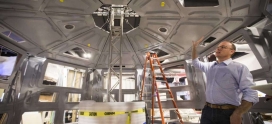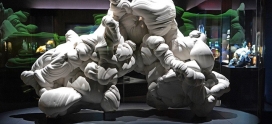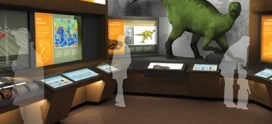
DALLAS — When you approach the new $185 million Perot Museum of Nature and Science, which opens here on Saturday, it is clear that you are not being led into a serene temple, where a harmonious cosmic order is going to be revealed. The building is alluring but unsettling. Is the museum’s 10-story concrete cube splitting apart or being pieced together? Is it being held intact by an enormous brace — a transparent protrusion on the cube’s side containing a 54-foot-long escalator — or is that a destabilizing gash that pierces the building’s body?
And does that cube seem to rest on an undulating acre of raised landscape planted with native Texas grasses because it is at home in that pastoral setting, or is the whole thing a map of eruption and cataclysm?
As seen from above, that rooflike plinth seems to ripple with promise, yet, from below, it can seem strewed with the sedimentary wreckage of the local skyline. The building is solemn with its robust abstractions and playful with its curves and striations. The architect Thom Mayne and his firm Morphosis Architects have created a structure that seems to be a manifestation of unseen forces, perhaps even reflecting processes not yet fully understood.
The effect isn’t false advertising, for within the museum’s 180,000 square feet of space and 11 exhibition halls (including a children’s museum), the visitor is led through a cosmos that can itself be dizzying: miniature worlds of systems and interactions; invocations of things known and half known; sensations, simulations and reflections; accounts of dissolution and evolution. It is a survey of the scientific universe, with galleries about space, fossils, birds, geology, weather, ecology, health, engineering and other fields.
You can stand inside a tent made of high-resolution video screens to tour the planets and then walk through a history of cosmology. You can trace the fossil record of a once-underwater Texas ecology and notice the prevalence of amateur fossil hunters in local paleontology. You can wear 3-D glasses while looking at a video of a mountainous scene, and glide through it as a virtual bird, by tilting your arms. You can alter the winds blowing across a virtual ocean’s surface or see how volcanoes accumulate along the boundaries of colliding tectonic plates.
One display shows the imposing drill bits used to extract oil from the earth, and you can find one of the few explanations in any science museum of how hydraulic fracturing, or fracking, works (along with a rumbling special-effects video ride, supposedly drilling into Texas’s untapped shale).
There are exquisite mineral crystals here, including a 1.5-ton geode whose halves you can manipulate with a wheel. There are slices of human cadavers mounted in glass; sensors that allow you to launch table-tennis balls with brain signals; simple robots that can be programmed to maneuver through a maze; a MIDI playpen of musical sounds and possibilities; and a 55-foot-long “running wall” — you can race alongside moving images of a full-size cheetah, a Tyrannosaurus rex or contemporary athletes.
This is not science approached through calm reflection or detached reverence. It is not the science of the traditional natural history museum, with its origins in the 19th century. It is the science of the “science center,” our era’s answer to earlier genres.
The center’s stage is typically immense, its claimed territory boundless, its age range universal. The center’s buildings are increasingly used as a demonstration of environmental principles (here that includes the capturing of rainwater and other sustainable practices). And its variety can be overwhelming.
That is part of the lure, for large audiences must be served. Science centers are meant to overwhelm, although, at their worst, the sensation of amazement comes more from the spectacle than from the subjects.
The Perot suffers from some of the genre’s flaws, particularly in the scale of its ambitions. Years of school curriculums are built into these displays, and entire lectures can grow out of a single label. It is difficult to absorb fully the history of cosmological exploration in a series of panels. Brief videos about particular scientists are meant to inspire aspirants, but few personalities are that intriguing, and most of them will probably remain unwatched.
And you can often feel spun about from the displays’ short attention spans. Twenty-five rock specimens map out Texas’s geology; the genetic foundations of evolution whiz by.
But the museum’s impact is considerable. The interest in design and spectacle is here, of course; in fact, the museum uses three exhibition design sources: Amaze Design, Paul Bernhard Exhibit Design and the Science Museum of Minnesota. But the cumulative effect comes not from the individual displays but from the museum’s overall spirit. You get a sense of the world as something immense, provocatively puzzling and worth exploring more closely. Even the benches here are meant to spur thought.
The Perot’s origins reach back to the 1936 Texas Centennial Exhibition, which created the Dallas Museum of Natural History. In 2006 the museum’s chief executive, Nicole Small, oversaw the uniting of that institution and two others at the nearby Fair Park: the Science Place and the Dallas Children’s Museum.
Once they were combined, Ms. Small said, attendance actually increased. But the ambition was to replace them with a new building that would seamlessly unite these variegated strands. It was named for Margot and Ross Perot after their children donated $50 million for its construction. Other benefactors were so forthcoming that the project was fully financed over a year ago.
You can see the unifying effect in the dinosaur hall, where contemporary animals and video screens accompany displays demonstrating, say, the relationships between predator and prey in different eras and modes: a Tyrannosaurus threatens the herbivorous Alamosaurus; the mountain lion eyes the mule deer; and below them all, a simple video game allows visitors to select their weapons (foul smell, tentacles, poison spray) and see how potential victims might defend themselves.
The gems and mineral hall becomes a haunting hybrid of old-style display and new-style interaction. In the darkened gallery, specimens stand illuminated in cases: aesthetic sculptures produced by ancient geologic processes, their fragile filaments and geometric crystals possessing astonishing beauty. But you can also sort them on a touch screen according to varied properties, or use another screen to examine their characteristics.
The exploratory impulse grows in the galleries devoted to human biology and mechanical engineering. Here the approach is scattershot rather than systematic, but in the area devoted to the body, there is an unflinching examination of its powers and failings. We learn of surgeries to correct curved spines, of the nature of aging and of the growing sophistication of artificial limbs. (But did my brain signals really launch those table-tennis balls? I have to try that again.)
The engineering displays are inspired by the spirit of the Exploratorium in San Francisco: you can construct working circuits using diodes, transistors, switches and other modules; build lightweight trusses and experiment with structures that remain stable in earthquakes; learn the difficulties of “autopilot” by slowly changing the feedback needed to maintain a toy helicopter’s altitude. It is an experimenter’s paradise, a demonstration of scientific learning arising out of doing.
Many of the galleries here are named for donors, and in the Texas Instruments Engineering and Innovation Hall, that means that we learn about that company’s innovations in the realm of chips, which is fully justified. The only time it seems to interfere with the substance is in the Tom Hunt Energy Hall, financed by a $10 million donation from Hunt Petroleum in Dallas (now owned by Exxon).
The Hunt Hall has its virtues. Some science centers treat environmentalism with almost devout attention, eager to drive home homilies, so it is a novelty to see it treated in this hall, as it is in other parts of the Perot, as one subject among many. It is refreshing as well to see some attention devoted to the engineering difficulties in the extraction of oil and get some idea of the science, however awkwardly presented.
But it is almost bizarre to see a major exhibit about energy whose central focus is on fracking and its machinery, even if the process ultimately transforms American energy production. We also get little sense of the controversies and debates that now fuel any examination of the energy issue. Even if the hall is meant to reflect Texan preoccupations, we learn in only a small part of a display case that “Texas produces more wind energy than any other state in the U.S.”
But that hall’s stumble does little to upset the suggestive force of a visit here. The test of even the most extravagant science center is not whether you leave satisfied or entertained, but whether you leave animated, a little unsettled, in a state that resembles wonder. And here, looking back, you do.




